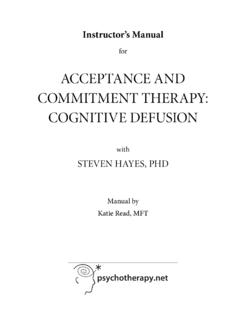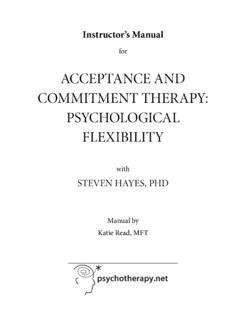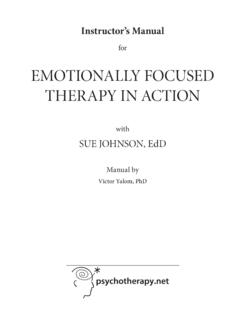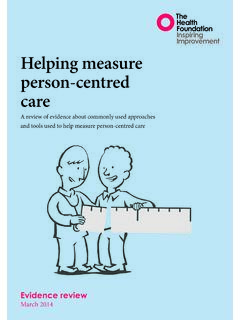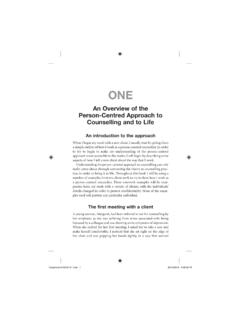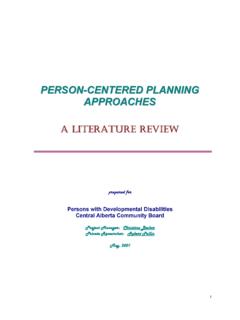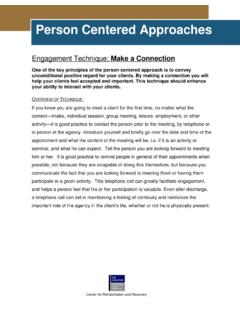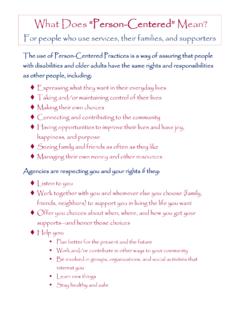Transcription of CARL ROGERS ON PERSON-CENTERED THERAPY
1 Instructor s ManualforCARL ROGERS ON PERSON-CENTERED THERAPY withCARL R. ROGERS , PHD, AND NATALiE ROGERS , PHD, REATM anual byAli Miller, MFT 2 CARL ROGERS ON PERSON-CENTERED THERAPYThe Instructor s Manual accompanies the DVD Carl ROGERS on PERSON-CENTERED THERAPY (Institutional/Instructor s Version). Video available at 2012, , LLC. All rights reserved. Published by Shoreline Highway, Building A, Suite 1 Mill Valley, CA 94941 Email: Phone: (800) 577-4762 (US & Canada)/(415) 332-3232 Teaching and Training: Instructors, training directors, and facilitators using the Instructor s Manual for the DVD Carl ROGERS on PERSON-CENTERED THERAPY may reproduce parts of this manual in paper form for teaching and training purposes only.
2 Otherwise, the text of this publication may not be reproduced, stored in a retrieval system, or transmitted in any form or by any means electronic, mechanical, photocopying, recording, or otherwise without the prior written permission of the publisher, The DVD Carl ROGERS on PERSON-CENTERED THERAPY (Institutional/Instructor s Version) is licensed for group training and teaching purposes. Broadcasting or transmission of this video via satellite, Internet, video conferencing, streaming, distance learning courses, or other means is prohibited without the prior written permission of the publisherMiller, Ali, MFT Instructor s Manual for Carl ROGERS on PERSON-CENTERED THERAPY Cover design by Julie GilesOrder Information and Continuing Education Credits.
3 For information on ordering and obtaining continuing education credits for this and other psychotherapy training videos, please visit us at or call s Manual forCARL ROGERS ON PERSON-CENTERED THERAPY Table of ContentsTips for Making the Best Use of the DVD 4 Summary of Carl ROGERS s PERSON-CENTERED Psychotherapy approach 5 Discussion Questions 8 Reaction Paper Guide for Classrooms and Training 13 Role-Plays 14 Related Websites, Videos, and Further Readings 16 Video Transcript 18 Video Credits 45 Earn Continuing Education Credits for Watching Videos 46 About the Contributors 47 More Videos 494 CARL ROGERS ON PERSON-CENTERED THERAPYTips for Making the Best Use of the DVD1.
4 USE THE TRANSCRIPTS Make notes in the video Transcript for future reference; the next time you show the video, you will have them available. Highlight or notate key moments in the video to better facilitate discussion during and after the FACILITATE DISCUSSION Pause the video at different points to elicit viewers observations and reactions to the concepts presented. The Discussion Questions section provides ideas about key points that can stimulate rich discussions and learning. 3. ENCOURAGE SHARING OF OPINIONSE ncourage viewers to voice their opinions. What are viewers impressions of what is presented in the interview?
5 4. SUGGEST READINGS TO ENRICH VIDEO MATERIALA ssign readings from Related Websites, Videos, and Further Reading before or after ASSIGN A REACTION PAPERSee suggestions in the Reaction Paper CONDUCT A ROLE-PLAYThe Role-Play section guides you through an exercise you can assign to your students in the classroom or training of Carl ROGERS s PERSON-CENTERED Psychotherapy approach * PERSON-CENTERED psychotherapy (also known as client- centered or Rogerian THERAPY ) is a form of talk THERAPY developed by Carl ROGERS in the 1940s and 1950s. The purpose of this form of THERAPY is to increase a person s feelings of self-worth, reduce the level of incongruence between the ideal and actual self, and help a person become more fully functioning.
6 ROGERS s strong belief in the positive nature of human beings is based on his many years of clinical counseling. He suggests that all clients, no matter what the problem, can improve without being taught anything specific by a counselor, once they accept and respect themselves. ROGERS (1986) described the foundation of his PERSON-CENTERED approach this way: It is that the individual has within himself or herself vast resources for self-understanding, for altering his or her self-concept, attitudes and self-directed behavior and that these resources can be tapped if only a definable climate of facilitative psychological attitudes can be to ROGERS (1957), in order for constructive personality change to occur, it is necessary and sufficient that the following conditions exist and continue over a period of time: 1.
7 Two persons are in psychological contact. 2. The first, whom we shall term the client, is in a state of incongruence, being vulnerable or anxious. 3. The second person, whom we shall term the therapist, is congruent or integrated in the relationship. 4. The therapist experiences unconditional positive regard for the client. 5. The therapist experiences an empathic understanding of the client s internal frame of reference and endeavors to communicate this experience to the client. 6. The communication to the client of the therapist s empathic 6 CARL ROGERS ON PERSON-CENTERED THERAPY understanding and unconditional positive regard is to a minimal degree , unconditional positive regard, and empathic understanding are the three core conditions of the PERSON-CENTERED approach to psychotherapy.
8 In A Way of Being (1980), ROGERS explains what he means by these three means that the therapist is genuine and authentic, not like the blank screen of traditional psychoanalysis:The first element could be called genuineness, realness, or congruence. The more the therapist is himself or herself in the relationship, putting up no professional front or personal facade, the greater is the likelihood that the client will change and grow in a constructive manner. This means that the therapist is openly being the feelings and attitudes that are flowing within at the moment. The term transparent catches the flavor of this condition: the therapist makes himself or herself transparent to the client; the client can see right through what the therapist is in the relationship; the client experiences no holding back on the part of the therapist.
9 As for the therapist, what he or she is experiencing is available to awareness, can be lived in the relationship, and can be communicated, if appropriate. Thus, there is a close matching, or congruence, between what is being experienced at the gut level, what is present in awareness, and what is expressed to the client. ( ROGERS , 1980)Unconditional positive regard involves basic acceptance and support of a person, regardless of what the person says or does:The second attitude of importance in creating a climate for change is acceptance, or caring, or prizing what I have called unconditional positive regard.
10 When the therapist is experiencing a positive, acceptant attitude toward whatever the client is at that moment, therapeutic movement or change is more likely to occur. The therapist is willing for the client to be whatever immediate feeling is going on confusion, resentment, fear, anger, courage, love, or pride. Such caring on the part of the therapist is nonpossessive. The therapist prizes the client in a total rather than a conditional way. ( ROGERS , 1980)Empathy means understanding accurately what the client is feeling, or stepping into his or her third facilitative aspect of the relationship is empathic understanding.


